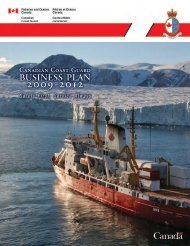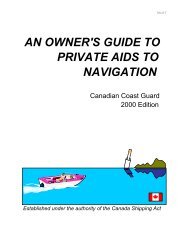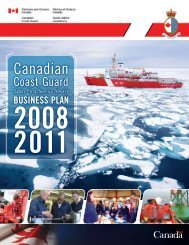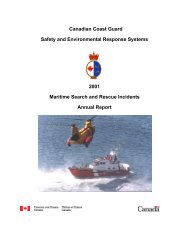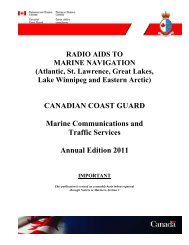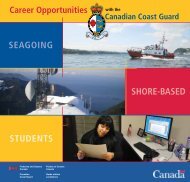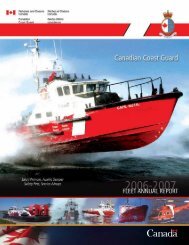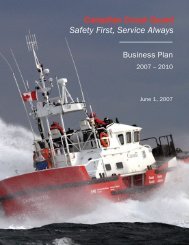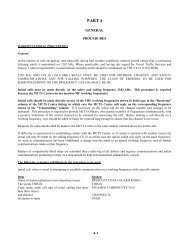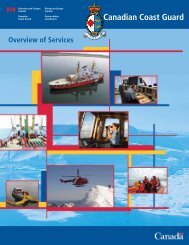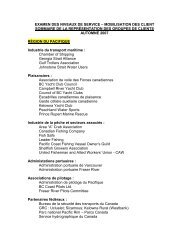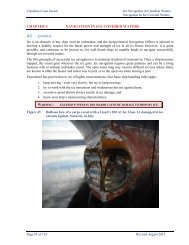RADIO AIDS TO MARINE NAVIGATION - Canadian Coast Guard
RADIO AIDS TO MARINE NAVIGATION - Canadian Coast Guard
RADIO AIDS TO MARINE NAVIGATION - Canadian Coast Guard
Create successful ePaper yourself
Turn your PDF publications into a flip-book with our unique Google optimized e-Paper software.
B. Reporting data. Amver participants need to be familiar with four types of reports - Sail, Arrival, Position, and<br />
Deviation Reports. Note that Amver permits sail plan and departure to be combined into a single report.<br />
Amver accepts sail plan information separately - for example, several days prior to departure. Report<br />
identifiers are as follows:<br />
AMVER/SP//<br />
AMVER/PR//<br />
AMVER/FR//<br />
AMVER/DR//<br />
Sail Plan & Departure<br />
Position Report<br />
Arrival Report<br />
Deviation Report<br />
C. Details. Paragraph IX includes a discussion of each report type. Each example is followed by an explanation.<br />
Note that not all the lines in the example are necessary for each type of report. The required and optional lines<br />
are discussed in each section.<br />
VII. Other Required Information<br />
Amver also needs other information which might be useful in an emergency. This includes data such as the ship length,<br />
communications equipment, radio watch schedule, speed, rig, and so forth. This information is collected separately once,<br />
by completion of the Search and Rescue Questionnaire (SAR-Q) found on the Amver Website at http://amver.com which is<br />
then retained in the automatic data processing system, periodically validated, and used only for search-and-rescue purposes.<br />
VIII. Release of Information<br />
All voluntary information collected under these instructions will be only released to recognized search-and-rescue<br />
authorities. Information regarding vessels required to participate in Amver will be forwarded to the U.S. Maritime<br />
Administration, via the keyword MAREP on the Y-Line.<br />
IX.<br />
Description of Voyage Reports<br />
An example and explanation of each of the four types of Amver reports follows. Numbers in parentheses refer to footnotes<br />
at the end of the section.<br />
A. Sail Plan & Departure Report. The “L” lines contain routing and “turnpoint” information needed by Amver.<br />
Amver needs data about every intended turnpoint, but also accepts information about any points along the intended<br />
track, even though they might not be turnpoints. Turnpoint information is needed by Amver to maintain plot<br />
accuracy.<br />
EXAMPLE:<br />
AMVER/SP//<br />
A/SANDY JOAN//ABCD//<br />
B/110935Z//<br />
E/145//<br />
F/126//<br />
G/NORVOROSK/4510N/03820E//<br />
I/GIBRALTERGI/3600N/00600W/140730Z//<br />
L/RL/140/4130N/02910E/112000Z//<br />
L/RL/140/4010N/02620E/112300Z//<br />
L/RL/140/3630N/02330E/120330Z//<br />
L/RL/140/3650N/01520E/121500Z//<br />
L/RL/140/3800N/01000E/130100Z//<br />
L/LR/060//<br />
M/GKA/GKM//<br />
V/MD/NURSE//<br />
X/NEXT/REPORT/120900Z//<br />
Z/SI<strong>TO</strong>R/INSTALLED/SELCALL/NUMBER/IS/99999/<br />
/<br />
Z//EOR<br />
EXPLANATION:<br />
Required -<br />
AMVER/SP//<br />
A /vessel/name/International Radio/Call Sign//<br />
B /intended time of departure or departure time// (1)<br />
G /port of departure/latitude//longitude// (2)<br />
I /port of destination/latitude//longitude/estimated time<br />
of arrival//(1) (2) (3)<br />
L / ...... route information ...// (1) (3) (4)<br />
Z // end of report<br />
Optional -<br />
E /current course// (5)<br />
F /estimated average speed// (6)<br />
M /current coastal radio station//next coastal radio<br />
station, if any//<br />
V /onboard medical resources// (7)<br />
X /up to 65 characters of amplifying comments// (8) (9)<br />
4-26



